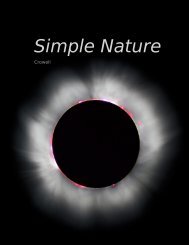Chapter 3 Acceleration and free fall - Light and Matter
Chapter 3 Acceleration and free fall - Light and Matter
Chapter 3 Acceleration and free fall - Light and Matter
You also want an ePaper? Increase the reach of your titles
YUMPU automatically turns print PDFs into web optimized ePapers that Google loves.
x (m) t (s)<br />
10 1.84<br />
20 2.86<br />
30 3.80<br />
40 4.67<br />
50 5.53<br />
60 6.38<br />
70 7.23<br />
80 8.10<br />
90 8.96<br />
100 9.83<br />
h / Discussion question D.<br />
136 <strong>Chapter</strong> 4 Force <strong>and</strong> motion<br />
Discussion questions<br />
A Show that the Newton can be reexpressed in terms of the three<br />
basic mks units as the combination kg·m/s 2 .<br />
B What is wrong with the following statements?<br />
(1) “g is the force of gravity.”<br />
(2) “Mass is a measure of how much space something takes up.”<br />
C Criticize the following incorrect statement:<br />
“If an object is at rest <strong>and</strong> the total force on it is zero, it stays at rest.<br />
There can also be cases where an object is moving <strong>and</strong> keeps on moving<br />
without having any total force on it, but that can only happen when there’s<br />
no friction, like in outer space.”<br />
D Table h gives laser timing data for Ben Johnson’s 100 m dash at the<br />
1987 World Championship in Rome. (His world record was later revoked<br />
because he tested positive for steroids.) How does the total force on him<br />
change over the duration of the race?














